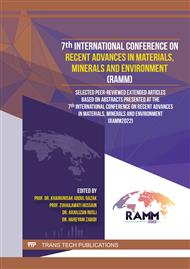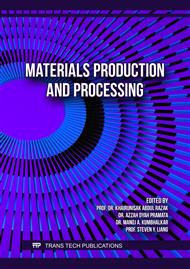[1]
Bai H, Zhong L, Kang L, Liu J, Zhuang W, Lv Z, and Xu Y, "A review on wear-resistant coating with high hardness and high toughness on the surface of titanium alloy," J. Alloys Compd., vol. 882, p.160645, Nov. 2021.
DOI: 10.1016/J.JALLCOM.2021.160645
Google Scholar
[2]
S. Mironov, Y. S. Sato, and H. Kokawa, "Friction-stir welding and processing of Ti-6Al-4V titanium alloy: A review," J. Mater. Sci. Technol., vol. 34, no. 1, p.58–72, Jan. 2018.
DOI: 10.1016/J.JMST.2017.10.018
Google Scholar
[3]
Cai D, Zhao X, Yang L, Wang R, Qin G, Chen D, and Zhang E, "A novel biomedical titanium alloy with high antibacterial property and low elastic modulus," J. Mater. Sci. Technol., vol. 81, p.13–25, Aug. 2021.
DOI: 10.1016/J.JMST.2021.01.015
Google Scholar
[4]
M. Abdel-Salam, S. El-Hadad, and W. Khalifa, "Effects of microstructure and alloy composition on hydroxyapatite precipitation on alkaline treated α/β titanium alloys," Mater. Sci. Eng. C, vol. 104, p.109974, Nov. 2019.
DOI: 10.1016/J.MSEC.2019.109974
Google Scholar
[5]
Karimi-Sibaki E, Kharicha A, Abdi M, Vakhrushev A, Wu M, Ludwig A, and Bohacek J, "A Numerical Study on the Influence of an Axial Magnetic Field (AMF) on Vacuum Arc Remelting (VAR) Process," Metall. Mater. Trans. B Process Metall. Mater. Process. Sci., vol. 52, no. 5, p.3354–3362, Oct. 2021.
DOI: 10.1007/s11663-021-02264-w
Google Scholar
[6]
H. K. Wang, Z. H. Wang, and M. C. Wang, "Using the Taguchi method for optimization of the powder metallurgy forming process for Industry 3.5," Comput. Ind. Eng., vol. 148, p.106635, Oct. 2020.
DOI: 10.1016/J.CIE.2020.106635
Google Scholar
[7]
T. K. Saothayanun, T. T. Sirinakorn, and M. Ogawa, "Layered alkali titanates (A2TinO2n+1): possible uses for energy/environment issues," Front. Energy 2021 153, vol. 15, no. 3, p.631–655, Sep. 2021.
DOI: 10.1007/S11708-021-0776-6
Google Scholar
[8]
H. Attar, M. J. Bermingham, S. Ehtemam-Haghighi, A. Dehghan-Manshadi, D. Kent, and M. S. Dargusch, "Evaluation of the mechanical and wear properties of titanium produced by three different additive manufacturing methods for biomedical application," Mater. Sci. Eng. A, vol. 760, p.339–345, Jul. 2019.
DOI: 10.1016/J.MSEA.2019.06.024
Google Scholar
[9]
A. Woźniak, O. Bialas, and M. Adamiak, "Improvement of the properties of Ti6Al7Nb titanium alloy in terms of the type of surface modification," Arch. Met. Mater, vol. 65, p.735–741, 2020.
Google Scholar
[10]
H. Chouirfa, H. Bouloussa, V. Migonney, and C. Falentin-Daudré, "Review of titanium surface modification techniques and coatings for antibacterial applications," Acta Biomater., vol. 83, p.37–54, Jan. 2019.
DOI: 10.1016/J.ACTBIO.2018.10.036
Google Scholar
[11]
C.-F. Liu, S.-J. Li, W.-T. Hou, Y.-L. Hao, and H.-H. Huang, "Enhancing corrosion resistance and biocompatibility of interconnected porous β-type Ti-24Nb-4Zr-8Sn alloy scaffold through alkaline treatment and type I collagen immobilization," 2019.
DOI: 10.1016/j.apsusc.2019.01.084
Google Scholar
[12]
Chen X, Zhu R, Gao H, Xu W, Xiao G, Chen C, and Lu Y, "A high bioactive alkali-treated titanium surface induced by induction heat treatment," Surf. Coatings Technol., vol. 385, p.125362, Mar. 2020.
DOI: 10.1016/j.surfcoat.2020.125362
Google Scholar
[13]
Y. T. Jian, Y. Yang, T. Tian, C. Stanford, X. P. Zhang, and K. Zhao, "Effect of pore size and porosity on the biomechanical properties and cytocompatibility of porous NiTi alloys," PLoS One, vol. 10, no. 6, Jun. 2015.
DOI: 10.1371/JOURNAL.PONE.0128138
Google Scholar
[14]
F. N. Ahmad and Z. Hussain, "Morphology and mechanical properties fabricated from Ti, Nb and HA by powder metallurgy method," in Journal of Physics: Conference Series, Oct. 2018, vol. 1082, no. 1.
DOI: 10.1088/1742-6596/1082/1/012083
Google Scholar
[15]
W. M. Tucho, V. H. Lysne, H. Austbø, A. Sjolyst-Kverneland, and V. Hansen, "Investigation of effects of process parameters on microstructure and hardness of SLM manufactured SS316L," J. Alloys Compd., vol. 740, p.910–925, Apr. 2018.
DOI: 10.1016/J.JALLCOM.2018.01.098
Google Scholar
[16]
A. Farrahnoor and H. Zuhailawati, "Effects of hydroxyapatite addition on the bioactivity of Ti-Nb alloy matrix composite fabricated via powder metallurgy process," Mater. Today Commun., vol. 27, p.102209, Jun. 2021.
DOI: 10.1016/J.MTCOMM.2021.102209
Google Scholar
[17]
H. C. Hsu, S. C. Wu, S. K. Hsu, C. W. Hsu, and W. F. Ho, "Bone-like nano-hydroxyapatite coating on low-modulus Ti–5Nb–5Mo alloy using hydrothermal and post-heat treatments," Thin Solid Films, vol. 687, p.137463, Oct. 2019.
DOI: 10.1016/J.TSF.2019.137463
Google Scholar
[18]
E. Yılmaz, A. Gökçe, F. Findik, and Ho. O. Gulsoy, "Metallurgical properties and biomimetic HA deposition performance of Ti-Nb PIM alloys," J. Alloys Compd., vol. 746, p.301–313, May 2018.
DOI: 10.1016/J.JALLCOM.2018.02.274
Google Scholar
[19]
Kim C, Kendall M, Miller M, Long C, Larson P, Humphrey M, Madden A, and Tas A, "Comparison of titanium soaked in 5 M NaOH or 5 M KOH solutions," Mater. Sci. Eng. C, vol. 33, no. 1, p.327–339, Jan. 2013.
DOI: 10.1016/j.msec.2012.08.047
Google Scholar
[20]
G. Tosun, M. Kilic, L. Ozler, and N. Tosun, "Characterization of a porous Nickel-Titanium alloy produced with self-propagating high-temperature synthesis," Jan. 2018.
DOI: 10.17222/mit.2017.156
Google Scholar
[21]
M. jiang Cen, Y. Liu, X. Chen, H. wei Zhang, and Y. xiang Li, "Inclusions in melting process of titanium and titanium alloys," China Foundry 2019 164, vol. 16, no. 4, p.223–231, Jul. 2019.
DOI: 10.1007/S41230-019-9046-1
Google Scholar



